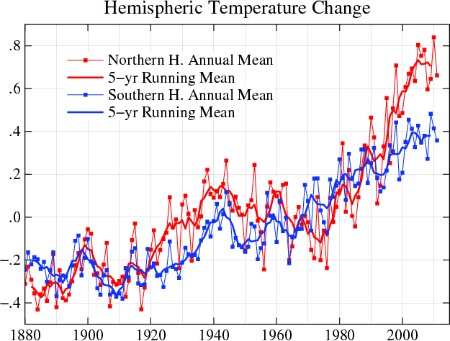If God-eh is keeping global warming at bay like Sen. James Inhofe assures us, then perhaps the rustbelt has been forsaken. A new study comparing station data and satellite photos concludes winter ice cover on America’s Great Lakes has plunged by 70 percent since 1973:
(MSNBC) — The study doesn’t include the current winter, but satellite photos show that only about 5 percent of Great Lakes surface froze over this winter, the Detroit Free Press said. That’s down from years such as 1979, when there was as much as 94 percent ice coverage. On average, about 40 percent of the surfaces freeze over, the newspaper said.
Annual variability in temperature and precipitation can explain some of the decrease. But the red plots in the NASA GISS temperature record above aren’t coincidence. They indicate average temperatures in the Northern Hemisphere over the last 130 years. Note the sustained uptick beginning in the mid 1970s.
On average, annual temperature readings in the northern half of the globe have increased by about 1.7° F, way over half of that delta has been in the last 40 years, and that figure may be a little on the low side for the Great Lakes. Climate change tends to be more extreme in boreal and polar regions because of a process called Polar Amplification. Ice and snow reflect more incident solar light back into space than darker land or water. In a warming trend, as ice cover decreases, less visible light is bounced back by shiny white snow and more energy is absorbed and radiated as heat by earth and sea, which is trapped by greenhouses gases before it can escape into space. This would be true even if GHG concentration were stable, let alone when they’re increasing. Researchers say the result of this positive feedback in the Arctic could be temperature increases two or even three times the global average and lead to ice-free summers in the next decade or two.


I’ve seen these graphs for years, and I still have no idea what metric is used to set the zero deviation point.
I’ll help James “Crashlander” Inhofe out here:
Obviously, the lack of ice on the Great Lakes is due to the fact that Jesus has recently taking up jogging. As Jesus runs across the surface of the lakes, the friction of his sneakers is generating heat that prevents the water from freezing.
I can ask Hansen or someone at NASA if you wish Gregory, what specifically is it you want to know?
FWIW, it was two or three years ago (I think) that Lake Superior (the biggest and coldest of the Great Lakes) was reported to have been the warmest ever recorded. With the mild winter we’ve had over the region I wonder if a new record will be set?
Gregory: It looks to me like the graph is the difference from a zero point in about 1966, where the red(northern) and blue (southern) annual lines both intersect the zero line. (I pasted the image into a drawing program and drew a couple of lines to determine this.)
Ok, be nice if I could edit that. Clicking on the image takes you to a page containing this and similar graphs. The caption for this one is:
So it appears it’s comparing annual temperatures with the mean temperature from 1951 to 1980. Or something.
Yeah Tre, I’m pretty sure that is the baseline used, but I’ll ask Jim or someone at GISS for cofnirmation if need be.